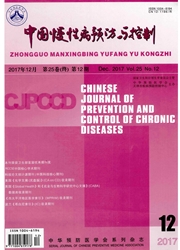

 中文摘要:
中文摘要:
目的探讨血尿酸(SUA)水平与代谢综合征(MS)的关系。方法于2007年3—4月在延吉市整群随机抽取3个单位,以参加健康体检且资料完整的1154名职工作为研究对象,测定血糖、血脂、SUA水平,测量身高、体重,计算体质指数(BMI),分析SUA水平与MS的关系。结果男性(n=468)和女性(n=686)MS组SUA水平均高于对照组。随着SUA水平的升高,男性BMI、收缩压(SBP)、舒张压(DBP)、总胆固醇(TC)和甘油三酯(TG)水平呈上升趋势,有统计学意义(P〈0.05,P〈0.01);女性年龄、BMI、SBP、DBP、TC、TG和LDL—C水平呈上升趋势,有统计学意义(P〈0.05,P〈0.01)。随着MS组分数目的增加,男性和女性SUA水平均上升,有统计学意义(r值分别为0.260和0.192,均P〈0.01)。Logistic回归分析结果显示,年龄、TG和BMI是男性SUA水平的影响因素;TG和HDL—C是女性SUA水平的影响因素。结论SUA水平与MS关系密切,且与MS组分数目密切相关。
 英文摘要:
英文摘要:
Objective To study the relationship between serum uric acid (SUA) levels and metabolic syndrome (MS). Methods Between March and April of 2007, data of 1 154 local subjects who received their health check-up in Yanji were collected, and then were analyzed on the association between SUA levels and MS. Results The SUA levels in both males and females with MS were higher than those in normal control groups. The levels of BMI, SBP, DBP, TC and TG significantly increased with increasing SUA in males, so were the levels of age, BMI, SBP, DBP, TC, TG and LDL-C in females (all P〈0.05 or P〈0.01 ). The levels of SUA showed significant increase with the number of components of metabolic syndrome in both male and female groups. Logistic regression analysis showed that the age, BMI and TG in males, while TG and HDL-C in females were influential factors for SUA levels. Conclusion There are significant correlations of SUA levels with MS and with the number of components of MS.
 同期刊论文项目
同期刊论文项目
 同项目期刊论文
同项目期刊论文
 期刊信息
期刊信息
